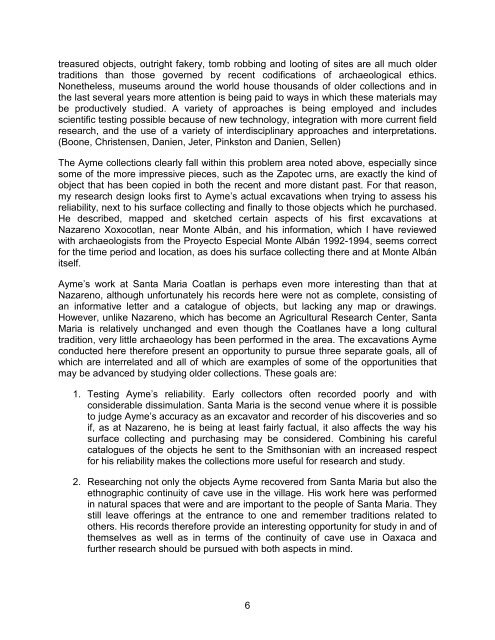Tracing Louis H. Ayme's Explorations in Oaxaca, México ... - Famsi
Tracing Louis H. Ayme's Explorations in Oaxaca, México ... - Famsi
Tracing Louis H. Ayme's Explorations in Oaxaca, México ... - Famsi
You also want an ePaper? Increase the reach of your titles
YUMPU automatically turns print PDFs into web optimized ePapers that Google loves.
treasured objects, outright fakery, tomb robb<strong>in</strong>g and loot<strong>in</strong>g of sites are all much older<br />
traditions than those governed by recent codifications of archaeological ethics.<br />
Nonetheless, museums around the world house thousands of older collections and <strong>in</strong><br />
the last several years more attention is be<strong>in</strong>g paid to ways <strong>in</strong> which these materials may<br />
be productively studied. A variety of approaches is be<strong>in</strong>g employed and <strong>in</strong>cludes<br />
scientific test<strong>in</strong>g possible because of new technology, <strong>in</strong>tegration with more current field<br />
research, and the use of a variety of <strong>in</strong>terdiscipl<strong>in</strong>ary approaches and <strong>in</strong>terpretations.<br />
(Boone, Christensen, Danien, Jeter, P<strong>in</strong>kston and Danien, Sellen)<br />
The Ayme collections clearly fall with<strong>in</strong> this problem area noted above, especially s<strong>in</strong>ce<br />
some of the more impressive pieces, such as the Zapotec urns, are exactly the k<strong>in</strong>d of<br />
object that has been copied <strong>in</strong> both the recent and more distant past. For that reason,<br />
my research design looks first to Ayme’s actual excavations when try<strong>in</strong>g to assess his<br />
reliability, next to his surface collect<strong>in</strong>g and f<strong>in</strong>ally to those objects which he purchased.<br />
He described, mapped and sketched certa<strong>in</strong> aspects of his first excavations at<br />
Nazareno Xoxocotlan, near Monte Albán, and his <strong>in</strong>formation, which I have reviewed<br />
with archaeologists from the Proyecto Especial Monte Albán 1992-1994, seems correct<br />
for the time period and location, as does his surface collect<strong>in</strong>g there and at Monte Albán<br />
itself.<br />
Ayme’s work at Santa Maria Coatlan is perhaps even more <strong>in</strong>terest<strong>in</strong>g than that at<br />
Nazareno, although unfortunately his records here were not as complete, consist<strong>in</strong>g of<br />
an <strong>in</strong>formative letter and a catalogue of objects, but lack<strong>in</strong>g any map or draw<strong>in</strong>gs.<br />
However, unlike Nazareno, which has become an Agricultural Research Center, Santa<br />
Maria is relatively unchanged and even though the Coatlanes have a long cultural<br />
tradition, very little archaeology has been performed <strong>in</strong> the area. The excavations Ayme<br />
conducted here therefore present an opportunity to pursue three separate goals, all of<br />
which are <strong>in</strong>terrelated and all of which are examples of some of the opportunities that<br />
may be advanced by study<strong>in</strong>g older collections. These goals are:<br />
1. Test<strong>in</strong>g Ayme’s reliability. Early collectors often recorded poorly and with<br />
considerable dissimulation. Santa Maria is the second venue where it is possible<br />
to judge Ayme’s accuracy as an excavator and recorder of his discoveries and so<br />
if, as at Nazareno, he is be<strong>in</strong>g at least fairly factual, it also affects the way his<br />
surface collect<strong>in</strong>g and purchas<strong>in</strong>g may be considered. Comb<strong>in</strong><strong>in</strong>g his careful<br />
catalogues of the objects he sent to the Smithsonian with an <strong>in</strong>creased respect<br />
for his reliability makes the collections more useful for research and study.<br />
2. Research<strong>in</strong>g not only the objects Ayme recovered from Santa Maria but also the<br />
ethnographic cont<strong>in</strong>uity of cave use <strong>in</strong> the village. His work here was performed<br />
<strong>in</strong> natural spaces that were and are important to the people of Santa Maria. They<br />
still leave offer<strong>in</strong>gs at the entrance to one and remember traditions related to<br />
others. His records therefore provide an <strong>in</strong>terest<strong>in</strong>g opportunity for study <strong>in</strong> and of<br />
themselves as well as <strong>in</strong> terms of the cont<strong>in</strong>uity of cave use <strong>in</strong> <strong>Oaxaca</strong> and<br />
further research should be pursued with both aspects <strong>in</strong> m<strong>in</strong>d.<br />
6
















